This is a KMZ Start Single Lens Reflex camera made by Krasnogorsk Mechanical Works (KMZ for short) in the former Soviet Union. This was the first Soviet made SLR aimed at professionals. Although it doesn’t look like it, the Start borrowed many design elements from the German made Ihagee Exakta SLR such as the removable prism with split image rangefinder, front shutter release with external coupling for automatic aperture, cartridge to cartridge loading system, and a razor blade to cut the film halfway through a roll. Because of their similarities, the Start earned the nickname “Russian Exakta”. Although the Start had an interchangeable bayonet lens mount, only one lens was ever made for it, the Helios 44. There was an optional M39 adapter which allowed Zenit SLR lenses to be used, but they would lose the automatic aperture feature. Although it was a pretty well built camera, it did not sell well and was only in production for a little over 5 years.
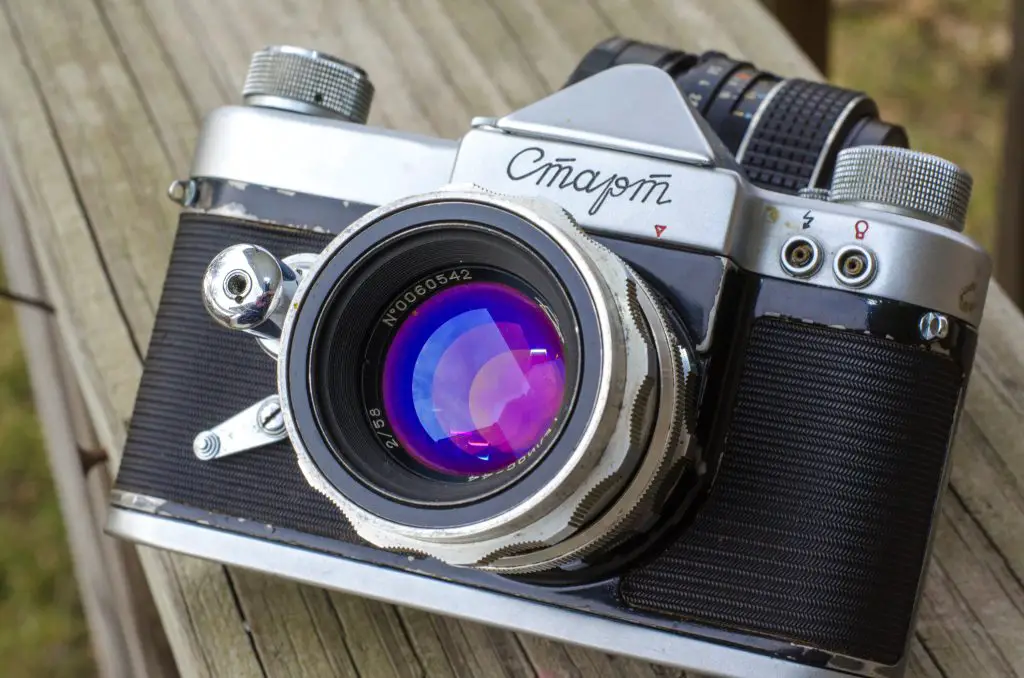 Film Type: 135 (35mm)
Film Type: 135 (35mm)
Lens Mount: KMZ Start Breech Lock Mount
Lenses: KMZ Helios 44 58mm f/2
Focus: Interchangeable SLR Prism
Shutter: Focal Plane Cloth
Speeds: B, 1 – 1/1000 seconds
Exposure Meter: None
Battery: None
Flash Mount: None
Manual: http://www.cameramanuals.org/russian_pdf/start-english.pdf
My Final WordHow these ratings work |
The KMZ Start can best be described as an ambitious missed opportunity. A lot of thought and effort was put into making this as great of a camera as could be made in the late 1950s. It is a fully featured camera that was clearly designed for the professional photographer, but for whatever reason, no other lenses and very few accessories were developed for it. It is a good looking camera with a very capable lens, that when found in good condition should be capable of excellent shots. Although I struggled to get consistent images from it, this review only represents one sample. It is entirely plausible that had I used a different Start, my results would have been different. Still, the ergonomics aren’t the best, the viewfinder does not compare favorably to two other competing 1950s SLRs, and it is heavy. This isn’t a camera I would go to for easy and spontaneous shots, but for a collector looking for what the best that the Soviet Union could offer back then, there is no better choice. | ||||||
| Images | Handling | Features | Viewfinder | Feel & Beauty | History | Age | |
| 1 | 0 | 2 | 0 | 2 | 1 | 20% | |
| Bonus | +1 for its innovative design and amazing lens | ||||||
| Final Score | 8.2 | ||||||
History
Krasnogorski Mekhanicheskii Zavod (KMZ) was an optical company based out of Krasnogorsk, Russia, a western suburb of Moscow who would take over primary optics production for the Soviet Union during World War II. Prior to the war, the source of most of the Soviet Union’s optical and camera technology was from the FED factory (named after Felix E. Dzerzhinsky) in Kharkov, Ukraine. FED had been building optical products such as the original FED camera which was an almost identical copy of the Leica II rangefinder since the mid 1930s.
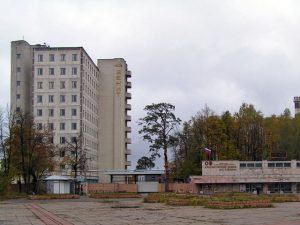
Although the FED factory saw success, their location was vulnerable to attack from German forces at the beginning of the war. Anticipating this, the Soviet Union moved most of the FED machinery and staff to the KMZ plant deeper into the Soviet Union, making it much less likely to be attacked. KMZ would make optical products such as scopes, binoculars, and other related items for the Soviet war effort until the conclusion of the war.
In 1945, KMZ would begin making photographic lenses based off designs from Zeiss-Ikon obtained by the red army during the war. In 1946, KMZ would release it’s first camera, the Moskva folding camera. The Moskva was a 6×9 medium format folding camera based off Zeiss-Ikon’s Ikonta and Super Ikonta cameras. In 1948, it would produce a camera nearly identical to the FED rangefinder, previously made in Ukraine prior to the war. Although the Soviet Union would rebuild the FED plant in Kharkov, it would take some time for them to resume production of their own camera, so for a while KMZ would make dual KMZ/FED cameras that were given the name ‘Zorki’. After a year or two, both plants would produce cameras that were nearly identical. That would change in the coming years as KMZ and FED would begin to change the design of their cameras, and as the years continued, the Zorki and the FED would start to look more and more different as each model would evolve in it’s own way.
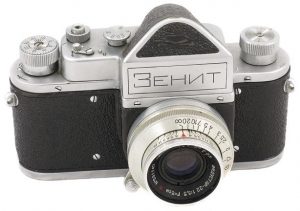
Through the 1950s, KMZ would achieve quite a bit of success as a camera manufacturer. At first, their products were limited to sales in the domestic market and Soviet influenced countries, but would eventually be exported to other European countries, and eventually to the United States. In 1952, KMZ would create their first Single Lens Reflex camera called the Zenit, which was actually based off the Zorki rangefinder, except with a larger mirror box and pentaprism viewfinder on top. Although spartan in features, the Zenit was a very solidly built camera that held up pretty well.
As the 1950s continued, camera makers from all over the world were incorporating more and more SLR models into their lineup. The SLR was increasingly being favored by professional photographers for their through the lens composition and interchangeable viewfinders and lenses. Although the Zenit was a well built model, it was pretty basic, and it’s Zorki based body limited it’s expandability.
In 1958, KMZ would release the Start SLR, the company’s first all new camera designed from the ground up. It was a very solid and heavy camera as it’s body was made out of molded iron. With the Helios lens attached, the camera weighs a hefty 924 grams.
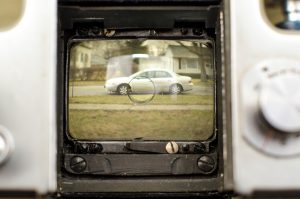
The Start was an ambitious camera, especially for the Soviets who up until this point mostly copied other people’s designs. It incorporated, and even improved upon quite a few unique features from the Ihagee Exakta such as an interchangeable viewfinder, breech lock lens mount, cassette to cassette film transport, and razor blade for cutting the film. It was also the very first Soviet camera with a wind lever instead of a knob.
The manner in which both the viewfinder and lenses attached were better than that of the Exakta. The lens mount was a simple breech lock system similar to the later Canon FD mount in which you line up two dots on the lens and body, and then rotate a collar to lock the lens in position. There is no need to rotate the lens like on a screw mount or bayonet mount system. The viewfinder was easy to attach and remove as you only needed to slide a release pin on the top left side of the camera and then the whole prism would slide out through the back of the camera. This was much smoother than the Exakta which had a clumsy release on the front of the camera that would often get stuck and require multiple tries to re-install the viewfinder.
The Start had a few other less noticeable, but still worthwhile features including a self timer, glass covered film reminder dial, a large and bright viewfinder, flash synced (at 1/30 sec) shutter, and dual door release keys on the bottom of the camera making sure that the film compartment stayed light tight.
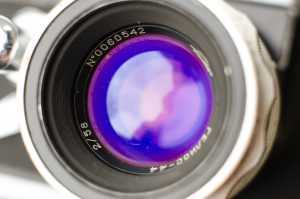
When it was new, the only lens available was the KMZ Helios 44 which was based off the Carl Zeiss Biotar 58/2 lens. KMZ did a good job copying the German design, and although the Helios 44 became a very capable lens on it’s own, it ended up being the only lens available for the Start. In my research, I cannot find any evidence that KMZ even started on any other lenses. I do not know if their plan was to release only the Helios 44 and then develop something later, or if other lenses were planned, but scrapped early on. While I am not an expert on the history of the Soviet Union, my understanding is that they were a very proud people, and it was not in their nature to admit defeat so easily, so even if the Start was selling poorly, I would have assumed that there should have been some evidence of more lenses being developed.
If a photographer wanted to swap lenses on the Start, there was an M39 adapter which allowed for screw mount lenses for the Zenit to be installed. Although these lenses would work, they would lose the external automatic diaphragm feature requiring the lenses to be used in stop down mode only, meaning that you had to set the aperture before composing your image and then shoot.
It is worth mentioning that the M39 screw mount for the Zenit SLR was not the same as the M39 mount used on the Leica and other rangefinders like the Zorki and FED. The screw threads had a different pitch which meant they could not be mounted and the two lenses had different flange focal distances. Rangefinder M39 lenses had a flange focal distance of 28.8mm and Zenit SLR M39 lenses were 45.46mm. This means that even if someone were to modify the screw threads to make them fit, a rangefinder M39 lens would never be able to focus to infinity on a Zenit or Start.
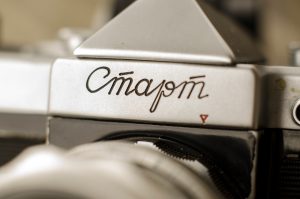
The Start saw up to 5 different subtle revisions throughout its production run, mine being a Type 1b version. Most of the revisions were subtle, including a redesigned film wind lever, redesigned film reminder disc, and other minor cosmetic changes. Later models were made for export and had the name “Start” in Roman lettering across the front of the prism as opposed to the early Cyrillic logo “Старт” like my example.
It is hard to say whether or not the Start was successful or not. It’s limited 5-6 year production run would suggest that it wasn’t. It is likely that the availability of only one lens and it’s heavy size probably turned off quite a few photographers. According to sovietcams.com, 76,503 models were made which might seem like a small number, but you have to consider the demand in the late 50s/early 60s for a professional grade SLR in the Soviet Union was probably limited. In addition, this same time period saw a huge increase in the availability and complexity of professional and semi-pro SLRs from Japan and Germany. Although a well built and ambitious design, the Soviets would have had to continually improve and refine the Start for it to stay competitive beyond the early 1960s.
A Start 2 was made which had a TTL exposure meter and automatic aperture, but they were produced in extremely limited numbers. In my research for this article, I could not find a single picture of one. There were even rumors of a Start 3 being developed, but none were ever finished.
Today, the KMZ Start is a pretty desirable camera for collectors of Soviet cameras and those who just like all mechanical cameras. It’s stance as a pro-level camera means it should be quite capable today. The availability of only one lens hampers it’s flexibility, but considering that one lens is the very highly regarded Helios 44, it’s not quite such a con as you might think. Speaking of the Helios, rumor has it that KMZ would hand pick the best examples off the Helios production line and use them for the Start. So if there was ever a “good” and “less good” Helios, these are supposedly the good ones. I don’t know if that has anything to do with the majestic bluish/purple glow from the lens coating, but it certainly is a visually stunning looking lens.
Repairs
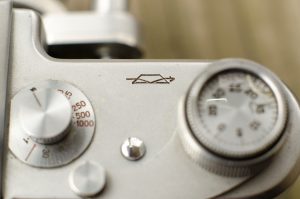
The Start arrived to me in pretty good shape. The slow shutter speeds are sluggish, specifically the second curtain. The first curtain appears to open at the correct speed, but the second curtain trails the first by quite a bit. Thankfully this goes away at 1/30 and above when the slow speed governor is not engaged. From my research, the Start uses a speed selector and slow speed governor that is very similar to that of the Zorki 4 which I have a lot of experience with. In essence, the slow speed governor is a separate gear driven module that rests on top of the speed selector. There is a pin on an arm that changes position depending on which speed is selected. At speeds 1/60 and below (except 1/30), this pin physically engages the slow speed governor which delays the closure of the second curtain. A little bit of gunk in the governor is most likely the cause of the sluggish second curtain. Since the governor is not engaged at speeds faster than 1/30, this would explain why both curtains move at the correct speed.
I could try to take apart the top plate of the Start, but I am apprehensive to do that as I am only 50/50 at repairing Soviet cameras. The Zorki 4 that I was successful at necessitated a repair since it didn’t work at all. I can live with the Start only having fast speeds as I rarely would use anything slower than 1/30 anyway.
The other issue that the camera had was a little more worrisome. The original design of the Start involved a mirror without the instant return feature similar to the Exakta. Instant return mirrors did not become common on SLRs until the early 1960s. How it works is that the mirror remains in the up position, blocking the prism and viewfinder when the shutter is not cocked. You must first cock the shutter in order for the mirror to drop down into the viewing position. When firing the shutter, the mirror would automatically move back into the up position, but it would stay there until you cocked the shutter again.
The problem I had was that the mirror wouldn’t ever stay in the ‘down’ position. I would see it momentarily drop into the lower position while moving the film advance lever, but upon full movement of the advance lever, the mirror would return to the ‘up’ position again completely blocking the viewfinder. You couldn’t compose your image with the shutter cocked because the mirror was blocking your view.
I wasn’t sure how difficult this would be to fix, but then a member of the Vintage Camera Collectors group on Facebook miraculously had a copy of a Soviet camera repair manual.
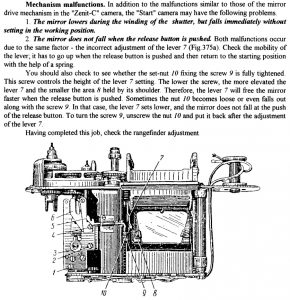
Here is a scan from that manual covering how to correct this issue. Under normal operation, when winding the camera, the mirror (number 8 in the image to the left) should lower into the taking position and the lever (number 7 in the image) should move backwards to “catch” the mirror. The issue was that the lever would get stuck on the edge of the mirror box preventing it from moving into position to “catch” the mirror.
I merely had to “adjust” the lever so that it wouldn’t get stuck. I had noticed that if I pressed really hard on the shutter release, the lever could get stuck again which would make the problem occur, but if that were to happen, all that would be required is to momentarily remove the lens and return it to the correct position and the mirror would be usable again. Hopefully this wouldn’t happen during shooting. Edit: It did.
Knowing that the camera’s speeds from 1/30 and up were working properly and I had a workaround to the mirror issue, I loaded in a roll of expired Kodak Plus-X from the early 1980s and went out shooting.
My Thoughts
I’ve been a fan of Soviet rangefinders since the first time I held a Kiev 4 rangefinder. Since then, I’ve acquired two FED 2s, a Zorki 4 and a second Kiev. In that time, I’ve run across multiple Zenit SLRs and was never impressed with them. Their brick-like and bulbous size turned me off. I was aware of the KMZ Start, but they aren’t nearly as common as the Zenits and as such, I really never targeted one. That all changed when I saw a Start included in a lot of cameras from a US seller in Atlanta, which I bought.
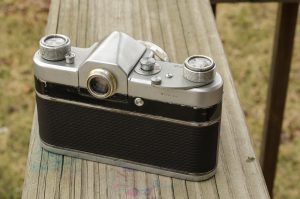
I was intrigued by the Start’s resemblance to the Ihagee Exkata to which I am already a big fan of. In some ways, the Start is a better camera than the Exakta in that it shares more common design elements with modern SLRs. For one, both the shutter release and wind lever are on the right side of the camera instead of the left, the Start has a more traditionally shaped body instead of the trapezoidal shape of the Exakta which makes it easier to hold, the design of the removable viewfinder is much easier to take off and put back on the Start, and finally, I actually prefer the Start’s removable film back to the hinged door of the Exakta. While normally a hinged door should be better than a removable back, I find that on both of the Exaktas in my collection, the latching mechanism is tricky to operate and I often struggle with closing both Exaktas. Once, I actually managed to get the latch stuck on an Exakta and I had worried that I broke it.
Without a doubt, the killer ‘con’ to the Start is that there is only one dedicated lens for it, the excellent Helios 44. Sure, there is that adapter that allows you to mount Zenit screw mount lenses, but I neither have that adapter, or any lenses that would work with it, plus you lose the automatic stop-down feature of the lens.
When looking at the Start in bright light, your eye is immediately drawn to the glowing bluish/purple hue of the Helios’ lens coating. I have never seen another camera with such a deep color to it’s coating. I’ve heard stories of Soviet cameras having radioactive lens coatings, and while that probably has nothing to do with the vivid color of the coating, it draws your eye to it every time. I’ve even had people ask me if online photos I’ve posted were doctored in Photoshop to enhance the blue “glow”, and I assure you, they have not.
In addition to the rumor that the Helios lenses selected for the KMZ Start were the “best of the best”, I encountered another rumor that Helios lenses starting with double-zeros meant that they were made specifically for VIPs. Who exactly would be considered a VIP or if this rumor is even true is anyone’s guess, but its at least noteworthy that my Start is not only an earlier model from 1959, but it does have a very low serial number on the lens.

The Start is a well built and solid metal camera with a lot of heft. It is certainly not the largest or heaviest camera ever made, but this is not a camera you would want hanging from a neck strap on a long vacation trip. If you plan on shooting with one of these, I recommend some type of sling backpack to put the camera in when not using it.
When I was about to take my Start out for it’s inaugural roll of film, I opened the back of the camera and noticed that mine was missing the take up spool. As was common of cameras from the 1950s, the take up spool is removable. The Start specifically allowed for cassette to cassette film loading (hence the razor blade), but this means that the take up spool can easily be lost over the course of 60 years. Thankfully, KMZ’s persistence in borrowing a lot of the design elements from the Ihagee Exakta, allowed me to use a take up spool from one of my Exaktas and it fit!
Using the Start is straightforward, thanks in part to the large and bright ground glass viewfinder. I found the split image rangefinder to be less useful than the one in the Exakta, but it is hard to tell if this is common to all KMZ Starts, or just my particular example. It does require that the lens is stopped down to maximize light into the viewfinder, but thankfully with the Helios lens, this isn’t a problem. I do not have the screw mount adapter for Zenit lenses, but I suspect that using a non-automatic aperture lens would darken the viewfinder, making it considerably harder to see through.
Since the Start does not have an auto return mirror, it is worth mentioning to someone who has never used a camera like this is that under normal operation, the viewfinder becomes blacked out as soon as you fire the shutter. The lack of an auto return mirror means that once you fire the shutter, the mirror moves into the upper position, blocking the viewfinder until you advance the film and cock the shutter for the next shot. This is hardly a deal breaker, but for someone not used to a camera like this, it means that you will lose sight of your subject through the viewfinder after taking a shot.
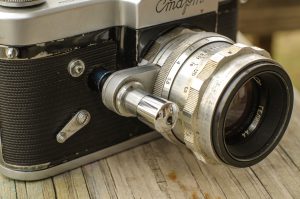
I’d say the biggest hurdle when shooting this camera is the extremely large shutter release. Like the Exakta, the shutter release is on the front of the camera, but there is an auxiliary shutter release button on the lens that sits in front of the camera’s actual shutter release. This puts the point where your finger needs to be quite far out in front of the camera. I would consider myself to have average sized hands so reaching the shutter release wasn’t a major problem for me, but I suspect that people with small hands would struggle with this aspect.
Another issue I had with the shutter release is that it requires quite a bit of pressure to fire the shutter because you are activating both the stop down feature of the lens and the shutter release on the camera itself. This is difficult to do smoothly, especially at slower shutter speeds, because the extra effort increases the chance of body movement in your hand. Another problem is that there is a bit of a “gap” in between when the aperture stops down and the shutter is released. If you are trying to gently fire the shutter, you will notice two different points where the lens stops down and then when the shutter actually fires. This can be a problem when trying to take time sensitive photographs of a moving child or pet. Although the Exakta has a similar issue with the external shutter release on the lens, on both Exaktas in my collection, the whole design is smoother and less intrusive. This by no means makes the Start unusable, its just something you need to be aware of when shooting.
Finally, one last quirk that is worth mentioning is that advancing film on the Start is not exactly smooth. Now, to be fair, I mentioned that I used a take up spool from an Exakta which appeared to fit well, but I’ll acknowledge that there is a possibility that the Exakta spool is ever so slightly different than an original spool which causes the film take up to be a little rough. On the other hand, many Soviet cameras have reputations of having many quirks, so it is entirely possible that even with a genuine Start take up spool, the film advance might still be a little janky. I was able to get through my first roll without any issues, but it’s worth noting that advancing the film in the Start is nowhere near as smooth as that of other SLRs.
My Results
I write reviews for this site in stages. I will often begin a review weeks, or even months before publishing the article, because I spend quite a bit of time researching the camera to learn more about it’s history. Then, if repairs are needed, I take the time to photograph and author my experience in whatever is needed to bring the camera back to a usable condition. Finally, it can often take quite a while for me to find the time to shoot a roll or two, and then get that film developed.
Occasionally, when I receive a roll of film back from the lab, I will discover that the results are not satisfactory and not indicative of what I believe that camera is capable of, so I’ll shelve a review until I can give it another chance. This was the case with the KMZ Start. I am writing this portion of the review in late June, but this review has been in draft status since January.
While I felt I vetted the camera to confirm that it should be capable of good shots, I foolishly loaded in an expired roll of Kodak Pan-X from ~1981. I guess I had thought that the gritty black and white look from expired B&W film would suit the KMZ’s history as a Cold War camera. Turns out that was not such a good idea. Every shot from that first roll was out of focus, extremely grainy and just overall looked pretty terrible. Here are a couple of shots from that first roll.
The above 4 photographs were the best of the 20 from the roll I shot with the Start. While not terrible, they all seem to be over exposed and lacking in focus. Plus-X is an ASA 125 speed film and knowing that it was 3+ decades old, I shot it as if it were an ASA 25 speed film by giving it 2 to 2.5 extra stops of exposure. Its possible that the Plus-X fared better than a typical 1981 film, and didn’t need so much over-exposure, or its possible that the Start’s cloth shutter had slowed down over time, giving it extra exposure. Whatever the case, my choice of film in this camera without any prior experience, and not knowing the condition of the film explains the overly saturated shots.
What was more concerning though, is that most of these shots are slightly, to way out of focus. These 4 shots were the best of the lot, and they all exhibit the same focus problem. There were several others which I am not sharing that were badly out of focus. This is troublesome considering this is an SLR where I should have been able to ‘see’ the focus better. Perhaps there is something with the lens throwing off the focal plane, maybe the film pressure plate isn’t keeping the film flat across the plane. Who knows. I made the decision to not finish this review until I was able to give this camera a second chance with more predictable film. For my second roll, I decided to split a 24 exposure roll of fresh Fujicolor 200 speed film between this KMZ Start and a Wirgin Edixa Reflex-C which I had some serious concerns about. I figured that if the Start still showed some problems, and that Edixa turned out to have issues as well, I would only waste one roll instead of two. Here is a link to that review of the Wirgin Edixa which shared this roll of film.
I was pleased to see that as I expected, the second roll showed quite a bit of improvement from that first roll, although the results weren’t stellar. The soft focus issues remain, which confirms that there must be some type of mechanical issue inside of the camera altering the focal plane. Oddly, two shots out of the 12 came out perfectly in focus so maybe the issue is intermittent. One of the in focus images is of the Kodak Recomar where I was focusing on the front lens standard. The other was just a boring shot of a beer can which I am not sharing. The two floral pictures do have elements in focus, but suspecting an issue with the camera, I shot those using a zone focus method so that something would be in focus. The biggest shame here is that these images are not indicative of the excellent sharpness that the Helios lens should be capable of. I have another review of a Petri SLR shot with a Helios 44-2 lens which fared much better. While I’ll acknowledge that my own sight can often play a part on focusing snafus using SLR cameras, I really can’t believe that I could so consistently be off so often with this camera.
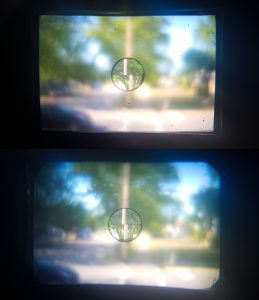
The KMZ Start was heavily inspired by the Exakta and one of those similarities is that both cameras have a prominent split image rangefinder in the center of the prism viewfinder. Oddly, I found that the split image wasn’t as useful as it is on the Exakta, or the similar Wirgin Edixa which has the same feature. I do not know if there is a flaw in my camera, or if the viewfinder simply isn’t as good as these other cameras, but I found that with the Helios lens wide open, I was unable to really see the split image move much when adjusting focus.
Look at the image to the left. The top image is through the viewfinder of a Wirgin Edixa and the bottom is through the KMZ Start. In both images, the lens is set to close focus, yet the telephone pole is greater than 100 feet away. Notice that on the Wirgin, the variation in the split image is greater than that of the Wirgin. It is very noticeable when your focus is so far off, but when you get closer to correct focus on the KMZ Start, the split image is so close, that it is really hard to get it perfect. For some reason, the split image in the Start doesn’t show enough variation to make fine focus easy to see.
Perhaps this variance is part of the reason so many of my shots were out of focus. This is a 57 year old camera that has always had a reputation for inconsistent quality control and its just possible that mine is suffering from normal issues, especially considering the age.
On the plus side, it was nice to see that the exposures were more on the ball. I shot all 12 images using Sunny 16 on fresh film and feel that the exposure was close enough to where I believe the shutter speeds are at least somewhat accurate. Also, the brilliant blue lens coating on the Helios lens renders colors very vividly, with a very modern appearance. Finally, none of the 12 images showed any light leaks which is great considering I made no effort to seal up the film compartment from leaks. It would appear that the original yarn light seals are still doing their job nearly 60 years later and that the cloth curtains have not yet developed any pinhole leaks.
The last comment I have about these images is that all of them show a black line across the top. This is exactly how the images came back from the lab, and I am glad they didn’t crop them out. I suspect this is a result of the take-up spool I used inside of the camera. I mentioned above that my Start was missing it’s original takeup spool, so I borrowed one from one of my Exaktas. It did the job, but it clearly is holding the film a millimeter or two too low across the focal plane.
So overall, while I still appreciate the KMZ Start’s looks and its history, its a bit of a downer to use. Could I have had better results from a different specimen? Perhaps. I still don’t like the extremely long shutter release. While I understand the need to position the shutter release more forward in order to attain the automatic stop down feature, this is something Ihagee had already sorted out with the Exakta prior to the KMZ Start being sold. There simply is no reason to put it so far forward. It is not comfortable to hold, and it makes holding the camera steady a challenge because of the extra effort required to fire the shutter. I wonder if using Zenit lenses with the Start -> M39 adapter might have provided a better experience, even though you lose the automatic stop down feature.
The viewfinder was the most difficult for me to use compared to 1950s Exaktas and a Wirgin Edixa, and the less than smooth film takeup just made for an overall unpleasant shooting experience. I know that Soviet cameras have a dedicated following and some might read this review thinking I hate the KMZ Start. On the contrary, I still like this camera and am happy that not only is it in my collection, but that I took the time to put 2 rolls through it. Will I ever shoot with it again? I honestly don’t know. While this camera definitely has it’s own quirks that are consistent with this hobby, when it comes time to shoot with a 1950s or early 60s SLR, I have so many better options in my collection.
Related Posts You Might Enjoy
External Links
https://alysvintagecameraalley.com/2022/04/13/the-kmz-start/
http://cameras.alfredklomp.com/start/
http://sovietcams.com/index.php?-2135336996
http://camerapedia.wikia.com/wiki/Start_(SLR)
http://www.wrotniak.net/photo/vintage/start.html
http://www.commiecameras.com/sov/35mmsinglelensreflexcameras/cameras/others/index.htm

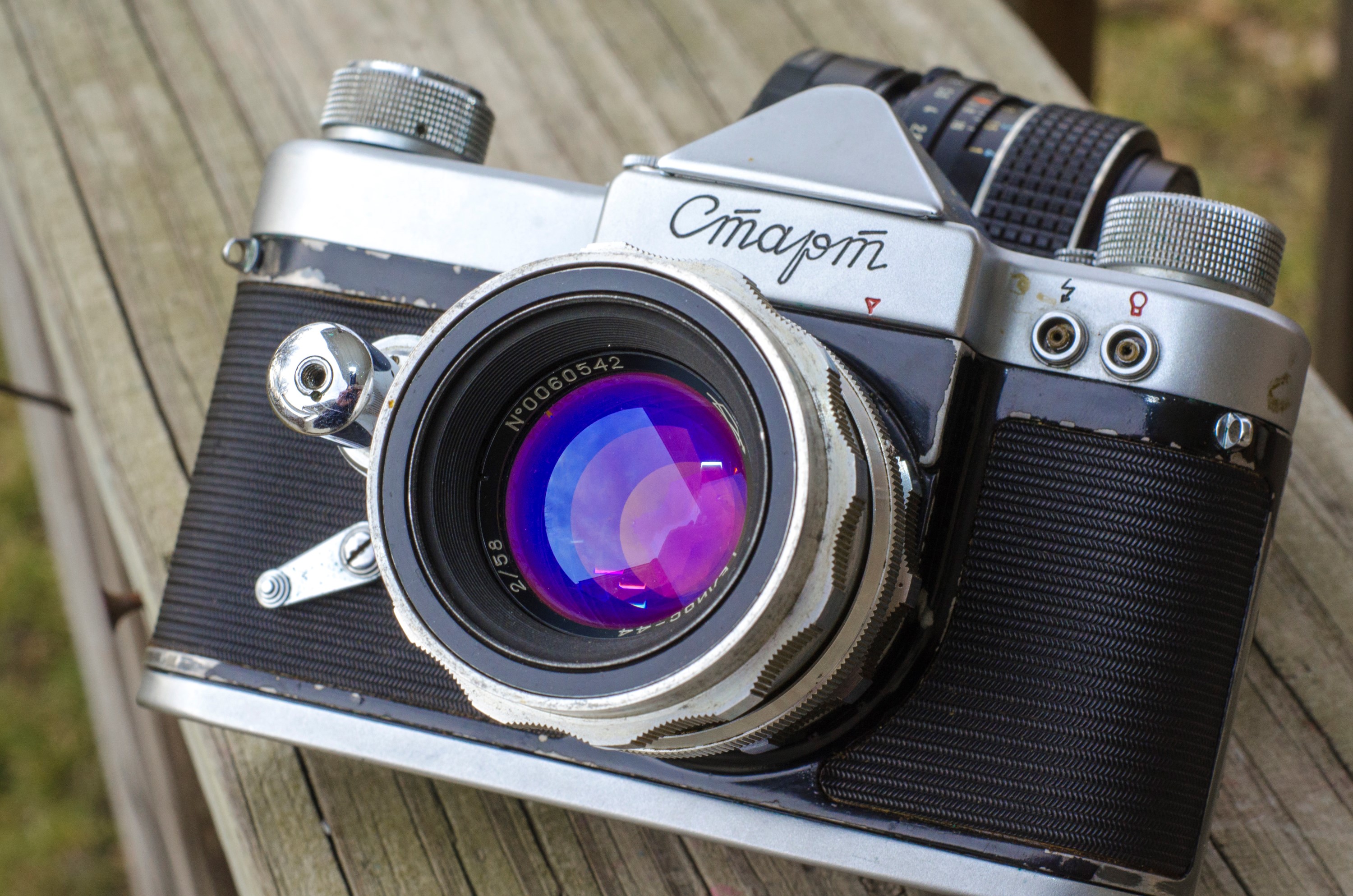
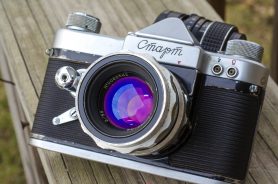












Hi, Honest review. I acquired a Start out of curiosity but have not yet put film through it. I agree that the shutter release requires concentration. One thing, (just to be picky,) is that the working distance of M39 soviet lenses for SLR is 45.2mm. The M42 lenses are 45.46mm.
Geoff, thanks for the response. I will make the correction for the M39 Zenit SLR adapter.
Hi, very detailed review. On the basis of the “Jean Loup Princelle” book, two lenses were presented during the 1958 worldfair in Brussels : MIR et TAIR-11 but like you said, none were produced.
If you wish to increase the focalizing accuracy, you could try to raise or below the glass under the prism (if possible).
It seems that one Start 3 has been identified (N° 6200006)
That is some very informative info, Thierry, thank you for sharing! 🙂
Mike, this is probably the best write-up of the Start on the net… I’ll bear this in mind when it comes to reviewing the Start on Zorki Photo.
Thanks for the tip on the Exakta take-up spool – my workaround using a plastic spool was giving me no end of grief!
Stephen
Stephen, thank you for the compliments! Although the Exakta spool mostly works, on mine, it kept the film about 1mm lower than it should have, resulting in a small black line running across my images. It is easily cropped out, and could possibly be unique to my camera, but it at least suggests that its not a perfect match.
Thanks for this great review! I just bought this camera hoping to use its lens on other cameras (oops!) but min was missing the take up spool. I’m very thankful that you took the time to mention your solution to the problem, even if it may be an imperfect one. I’m looking forward to shooting with this interesting camera!